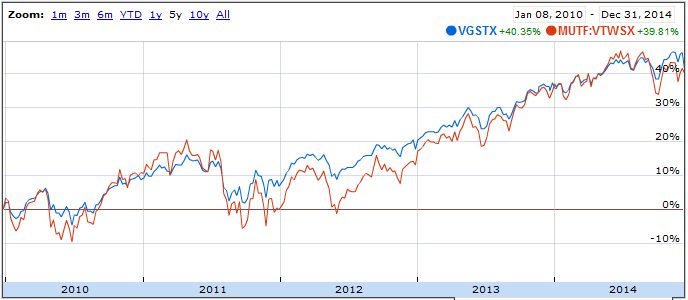 Earlier on the blog, David Marotta wrote about investing in one fund if you wanted to keep things very simple (even more simple than his gone-fishing portfolio).
Earlier on the blog, David Marotta wrote about investing in one fund if you wanted to keep things very simple (even more simple than his gone-fishing portfolio).
He suggested the Vanguard STAR Fund (VGSTX), which has the following benefits:
- Low expense ratio of 0.34% (which Vanguard says is 64% lower than the average expense ratio of funds with similar holdings)
- It’s a 60% stocks, 40% bonds/cash fund, which gives a smoother, more moderate ride on the bumpy stock market
- It’s a blend of several other Vanguard funds
- It has a minimum initial investment of $1,000, which is the lowest minimum investment of any Vanguard mutual funds
An alternative to the STAR fund is the Vanguard Total World Stock Index Fund (VTWSX), which has the following characteristics:
- Low expense ratio of 0.30% (which Vanguard says is 77% lower than the average expense ratio of funds with similar holdings)
- It’s a 100% stock fund: 9% emerging markets, 22% Europe, 13.5% Pacific, 0.2% Middle East, 55.3% North America. Although it is 100% stocks, it has stocks from all over the world, some of which will do well while others under-perform in any given year. Taking a tiny slice of the entire world smooths the ride a bit for the investor.
- It has a minimum initial investment of $3,000, which is more than the STAR fund, but not bad when you consider you are buying a slice of the world market
| Average Returns | ||||
| 1 Year | 3 Years | 5 Years | ||
| STAR Fund | VGSTX | 7.35% | 12.90% | 13.13% |
| Total World Fund | VTWSX | 3.92% | 14.34% | 9.22% |
Here is a chart comparing the STAR Fund with the Total World Stock Index Fund over the past 5 years. The STAR Fund has been around since 1985, but the Total World fund was created in 2008, which is why we cannot yet compare longer time periods:

Either of these funds would be a good choice for a one-fund investment if you really want to keep it simple, and you could invest in both of them if you want a two-fund strategy.